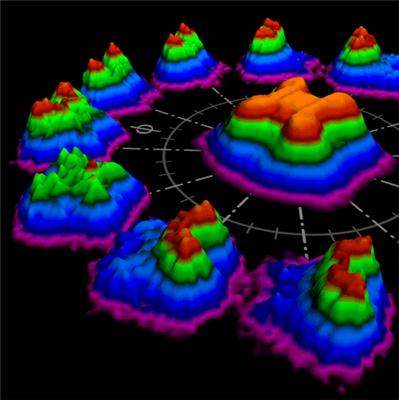An agitation is created on the micro scale by a strong laser pulse, when interacted with an atom. This results in single ionization, from which one electron is expelled out from the atom. Similarly, removal of two electrons from an atom leads to the complexity of double ionization process.
 Artist's view of non-sequential double ionization. The 3D plots on the circle were obtained from experimental data and show how the velocities of the two electrons change with the electric-field evolution of the ionizing pulse. The plot in the center is the sum of all these single measurements. From these data, the scientists can reconstruct the detailed process of the double ionization. Courtesey of Christian Hackenberger/ LMU
Artist's view of non-sequential double ionization. The 3D plots on the circle were obtained from experimental data and show how the velocities of the two electrons change with the electric-field evolution of the ionizing pulse. The plot in the center is the sum of all these single measurements. From these data, the scientists can reconstruct the detailed process of the double ionization. Courtesey of Christian Hackenberger/ LMU
Scientists from the Laboratory for Attosecond Physics located at the Max Planck Institute of Quantum Optics partnering with associates from the Max Planck Institute for Nuclear Physics led a global team, who has noticed the thorough interaction process on attosecond time scales.
This interaction process is similar to a billiard game, wherein a ball makes another one to move after collision. The scientists have examined and found many similarities between the non-sequential double ionization and a collision between billiard balls. A part of the energy is transferred from one electron to a second electron during the collision process and a second electron moves to the core’s excited phase. The second electron is liberated from the atomic core due to an electric field present in the laser pulse.
Researchers and other partners have limited a non-sequential double ionization event to recollision of a single electron and excitation event that allows tracing this interaction method on attosecond time scales.
In order to attain this, a four femtosecond long laser pulse was sent by the researchers onto argon atoms. Two wave minima and two wave maxima constitute the pulse’s light waves. The laser field enabled single ionization of most atoms. Each thousandth atom underwent non-sequential double ionization. When the first electron is ionized, around 1.8 femtoseconds was taken by the atom to revisit the atomic core and stimulate a second electron. For approximately 400 attoseconds, the electron was in the excited state before the release of the electron from the core through laser field.
These observations are made the researchers to go deep into the quantum dynamics of a multi-electron system, driven by laser.